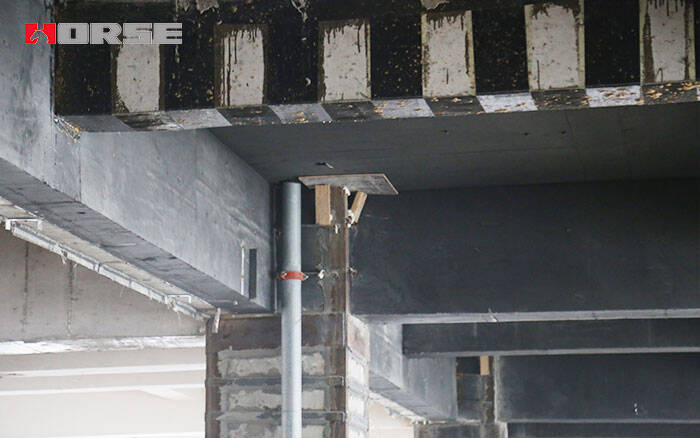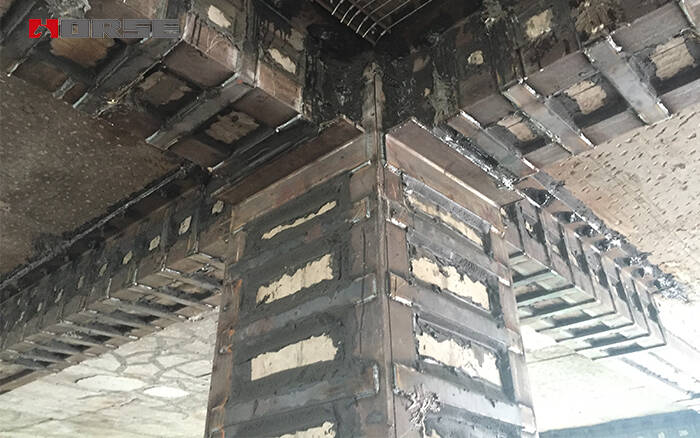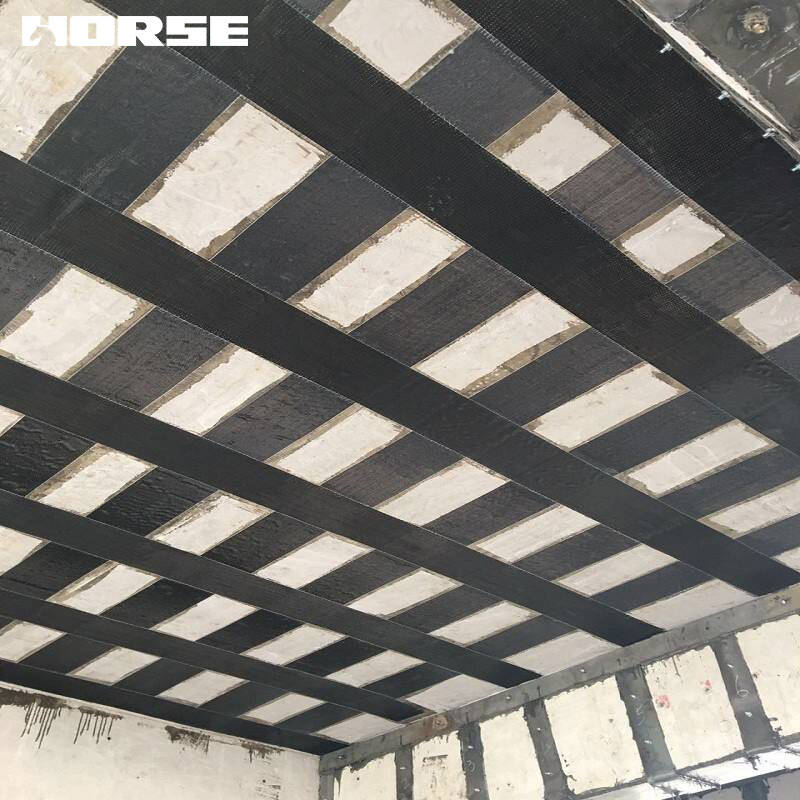Solutions
Horse Construction offers full range of structural strengthening materials with technical supports, documentation supports, products supports, project supports.
Building reinforcement method

Due to the occurrence of certain natural disasters and human factors, the original structure may no longer meet the current use requirements, but the existing buildings still have a certain use value. In order to meet the functional requirements of the structure, the structure must be reinforced.
The main factors that cause the structure to not meet the requirements for use include:
①Improper use and management of existing buildings, long years of disrepair, damage to the structure, etc., which cannot meet the current requirements for use or lack of safety;
②The occurrence of catastrophic events (such as earthquakes, fires and explosions, etc.) causes cracking and destruction of the structure;
③Reconstruction, expansion, addition, or decoration of existing buildings in the layout of components, which affects the original structural system;
④The existing buildings have quality problems due to design and construction;
⑤ The use function of the existing house has changed, causing the original structure to fail to meet the use requirements.
The occurrence of the above factors may cause a certain component of the structure or the entire structure to fail to meet the safety requirements. The designer needs to select an appropriate reinforcement method for each dangerous component or the overall structure. This article will briefly introduce the reinforcement methods of each member of the structure.

1 Concrete beam reinforcement method
1.1 Enlarged beam section reinforcement method
Enlarged beam section method refers to pouring a layer of new concrete soil above or below the component and adding corresponding steel bars to increase the bearing capacity of the beam. When adding concrete in the compression zone of the beam, the effective height of the beam can be effectively increased, thereby improving the bending and shearing bearing capacity of the beam, and increasing the rigidity of the member. Re-pouring concrete in the tension zone of the beam can bond and protect the re-poured steel bars. The reinforcement effect of the enlarged section method is directly related to factors such as the stress level, material properties, construction technology, joint surface structure treatment, and whether to unload reinforcement during the reinforcement of the original structure. The advantage of this method is that the process is simple and the application is wide. The disadvantage is that the increase of the beam section will also have a certain impact on the house clearance.
1.2 External steel reinforcement method
The steel-clad method of strengthening the beam has the advantages of large reinforcement and wide application range. However, there are also limitations such as the large difference between the design calculation and the actual force, the high requirements for node processing, and the relatively high cost of reinforcement construction. In order to ensure the stress transmission, both ends must be reliably anchored to the stressed column when the beam is reinforced by the steel-clad method. This often results in some additional column-clad steel costs in actual projects. Therefore, this method is more suitable for use in projects where beams and columns need to be reinforced at the same time.
1.3 Prestressed reinforcement method
The pre-stressed reinforcement method is the method of strengthening the structure by adding pre-stressed steel tie rods or bracing rods. Prestress is applied to force the tie rods or struts to affect and change the internal force distribution of the original structure, thereby reducing the original stress level of the structure and improving the bearing capacity of the structure. The characteristic is to force a part of the force to be added to the post by means of prestress, which changes the internal force distribution of the original structure and reduces the stress level of the original structure. The stress-strain hysteresis characteristic of general reinforced structures can be completely eliminated. It has the triple effect of strengthening, unloading and changing the internal force of the structure. The post-added part and the original structure can work together well, and the structural bearing capacity can be greatly improved.
1.4 Additional support point reinforcement method
The additional fulcrum reinforcement method is a reinforcement method that reduces the structural calculation span by adding fulcrums, changes the internal force distribution of the structure, and improves its bearing capacity. After adding a support point in the middle of the beam, the span is reduced, which can greatly increase the bearing capacity and reduce and limit the deflection and deformation of the beam. It is suitable for the reinforcement of beams in large-span structures with unrestricted house clearance. The advantage of the additional support point reinforcement method is that it is simple and reliable, but the disadvantage is that the use space will be affected to a certain extent.
1.5 Reinforcement method by sticking steel plate
The bonding steel reinforcement method is a reinforcement method in which a special building structure glue is used to paste the steel plate on the surface of the concrete beam to make it work together and to receive the overall force to improve the bearing capacity of the beam. The essence of this reinforcement method is a kind of external reinforcement. Increase the amount of reinforcement of the original concrete beam, thereby correspondingly improving the rigidity, tensile, compressive, bending, and shearing capabilities of the beam. The use of this method for reinforcement requires high structural adhesives. The structural adhesives must have high strength, strong bonding force, aging resistance, high elastic modulus, low linear expansion coefficient, and certain elasticity. Compared with traditional reinforcement methods, the bonding steel reinforcement method is simpler and faster, and has less impact on the shape and clearance of the structure. The construction process has less impact on production and life, so it is widely used in the construction field.
1.6 Carbon fiber cloth reinforcement method
The carbon fiber cloth reinforcement method is usually to paste carbon fiber cloth on the bottom surface of the beam with a high-performance adhesive so that the two work together to improve the bending and shear resistance of the beam, thereby achieving the purpose of strengthening and strengthening the beam. Before sticking the carbon fiber cloth, surface treatment should be performed on the beam bottom sticking area. The purpose is to remove the weak layer on the concrete surface, expose a solid concrete layer and polish it smoothly, so as to ensure reliable bonding between the carbon fiber cloth and the concrete. The advantages of strengthening the beam with carbon fiber cloth are that it can greatly increase the bearing capacity of the beam and increase the rigidity of the beam, and because the carbon fiber has a light weight, it basically does not increase the weight of the structure and the cross-sectional area of the beam after reinforcement.

2 Reinforcement method of concrete column
2.1 Enlarged column section reinforcement method
Enlarged column section reinforcement method is to wrap concrete on one side, two sides, or around the concrete column according to the force of the column. A reinforcement method to increase the cross-sectional area of the column and the amount of reinforcement, so as to achieve the purpose of improving the bearing capacity of the component and increasing the strength and rigidity of the column to meet the requirements of normal use.
2.2 Reinforcement method of column-clad steel
The column-clad steel reinforcement method is to wrap a section steel (generally an angle steel) on the two or four corners of the concrete column. Angle steel is welded on the flat steel hoop to enhance its rigidity and stress performance. It is widely used in the reinforcement of frame columns.
2.3 Carbon fiber reinforcement method
The use of carbon fiber cloth to reinforce reinforced concrete columns often adopts the method of transverse wrapping. The restraint of carbon fiber cloth on the concrete is similar to the restraint effect of the stirrup, which can make the wrapped concrete in a three-way compression state. The restraining effect of carbon fiber cloth is a passive restraint. As the axial force of the concrete increases, the transversely expanding carbon fiber cloth produces hoop elongation, so as to achieve the purpose of laterally restraining the concrete. The inner core concrete of the reinforced column is subject to the bidirectional restraint action of the stirrup and the outer carbon fiber cloth, and still has good deformation performance when the concrete reaches the peak stress.
2.4 Bonding steel reinforcement method
The bonding steel reinforcement method is to use high-strength cementitious concrete to increase the section of the column by a small amount, and to wrap the bonding angle steel and the bonding steel plate. While the newly added section increases the bearing capacity of the column, it also produces a good three-dimensional stress state for the original concrete column due to the lateral restraint effect of the newly added steel plate hoop. Therefore, the bearing capacity of the column can be greatly improved, and the deformation resistance of the column is also improved. The advantage of this reinforcement method is that the bearing capacity of the column is greatly improved when the cross-sectional area of the column is not increased much.

3 Reinforcement method of slab
3.1 Sticking carbon fiber cloth reinforcement method
The principle of sticking carbon fiber cloth reinforcement is to use high-strength structural glue to stick the carbon fiber cloth to the surface of the floor slab. The carbon fiber and the floor slab concrete members bear the force together, thereby improving the bearing capacity of the floor slab. Carbon fiber has the advantages of high strength, corrosion resistance, convenient construction, and basically does not change the size of the component after reinforcement, so it is widely used in the reinforcement of floor slabs.
3.2 Bonded steel reinforcement
Bonded steel reinforcement is a reinforcement method that uses building structural glue to paste steel plates on the surface of the concrete floor, thereby improving the bearing capacity and deformation capacity of the floor. Bonded steel reinforcement can improve the flexural, tensile, shear, and compressive mechanical properties of the floor slab.
In conclusion
The article summarizes the reinforcement methods of different structural members in detail, and points out the advantages and disadvantages of each method. In the actual reinforcement application, the overall reinforcement form and reinforcement requirements of the building should be combined, and the construction characteristics and reinforcement cost should be considered comprehensively, and the reinforcement method should be selected reasonably to achieve the expected reinforcement effect.
You can find anything here you are in need of, have a trust trying on these products, you will find the big difference after that.

High strength carbon fiber reinforced polymer (CFRP) strip / laminate / plate for structural strengthening and concrete repair

Two-component epoxy modified epoxy structural strengthening adhesive for bonded steel plate to concrete

High strength, unidirectional carbon fiber sheet pre-saturated to form a carbon fiber reinforced polymer (CFRP) sheet used to strengthen structural concrete elements.